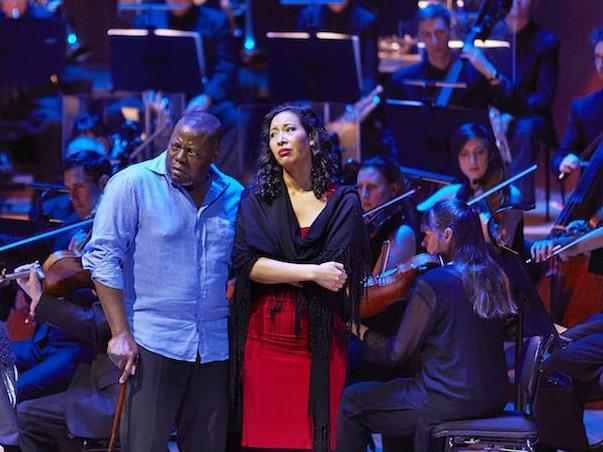Alfred Walker and Nicole Cabell in The Gershwins’ Porgy and Bess. Photograph by Keith Saunders.
George Gershwin’s Porgy and Bess is often dubbed ‘the great American Opera’. It’s a story of love and loss as seen through the eyes of the locals living on Catfish Row, a poor tenement in South Carolina. Gershwin had a particular interest in the African-American experience and was passionate about black American music; using blues and jazz in even his earliest works.
Written as a folk opera in three acts, Porgy and Bess was a labour of love for the composer, taking almost ten years to come to the stage. The show finally opened at the Alvin Theatre in New York on October 1935 and ran for a respectable 124 performances. But it’s the songs – especially the jazz classic ‘Summertime’ – that really make Porgy and Bess so memorable.
This semi-staged production has the principal singers at the front of the stage on an extension coming into the stalls. The orchestra, led by the SSO’s chief conductor and artistic director David Robertson, is centre stage with the massed Sydney Philharmonia Choir in raised seating at the back. The few props – some crates, a chair, a trestle for the dead – are managed by the singers.
Robertson led the orchestra with his usual élan, conducting with graceful precision. He successfully created a colourful synergy between the singers, players and choir.
Alfred Walker’s rich bass-baritone gave Porgy a warm humanity, even though he’s not a particularly likeable character. Soprano Nicole Cabell brought out the sadness in Bess and displayed a superb sense of lyric and pace. And Eric Greene was suitably menacing, physically and vocally, as Crown. Jermaine Smith was the audience favourite playing Sporting Life with a musical theatre flair.
The combined effect of orchestra, massed choir and operatic voices was powerful and individually each element was quite exceptional. Each of the principal singers were well-cast and together gave a rich vocal interplay.
As always in opera, the songs drive the narrative and sadly much of the emotional intensity of the story was lost because the words were virtually unintelligible. You can’t share the characters’ hopes and dreams, and empathise with their pain if you don’t know what’s going on. It wasn’t that the singers were overwhelmed by the orchestra, rather the lyrics were indistinct. This was apparent even when the singers were so far downstage as to be almost touching the audience seated in the front row. The lack of clarity really did undermine the performance and resulted in disappointing renditions of so many great songs including ‘Summertime’,’ It ain’t Necessarily So’ and ‘I Got Plenty O’nuttin’.
Porgy and Bess is a wonderful period piece, a fully-sung drama using operatic techniques – but this semi-staged production was ultimately unfulfilling. The addition of surtitles may have significantly enhanced the audience’s appreciation of this delightful show.
Rating: 3 stars out of 5
The Gershwins’ Porgy and Bess
by George Gershwin, DuBose and Dorothy Heyward and Ira Gershwin
PROGRAM
GERSHWIN Porgy and Bess
Artists
David Robertson conductor
Alfred Walker Porgy
Nicole Cabell Bess
Eric Greene Crown
Karen Slack Serena
Julia Bullock Clara
Leon Williams Jake
Jermaine Smith Sportin’ Life
Sydney Philharmonia Choirs
Stage Director
Mitchell Butel
Sydney Symphony Orchestra
Sydney Opera House Concert Hall
26 November – 3 December 2016





